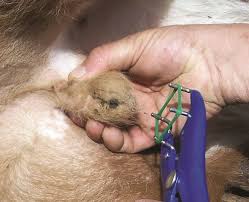Reasons why Pregnant Sheep Die by the Road-side and How to Control it
There are lots of things that may be responsible for this regular issue of people complaining that they do see a lot of dead pregnant sheep along the road-side.
It may be due to road accident which is common to sheep and goat raised in an extensive system. Another common cause is what is known as “pregnancy toxaemia” of sheep which refers to the state whereby the sheep is stressed during pregnancy. Lowered level of glucose at this stage will cause pregnancy toxaemia which does result in the death of the pregnant sheep.
To prevent this, pregnant sheep should be given adequate care in terms of feeds and other management procedures. Stressful conditions should be avoided at all cost.
Meanwhile, Domestic sheep reproduce sexually much like other mammals, and their reproductive strategy is furthermore very similar to other domestic herd animals.
A flock of sheep is generally mated by a single ram, which has either been chosen by a farmer or has established dominance through physical contest with other rams (in feral populations). Most sheep have a breeding season (tupping) in the autumn, though some are able to breed year-round.
Largely as a result of the influence of humans in sheep breeding, ewes often produce multiple lambs. This increase in the lamb births, both in number and birth weight, may cause problems in delivery and lamb survival, requiring the intervention of shepherds.
Read Also: Livestock Farming: Best Route of Drug Administration for Ruminants
Pregnancy Toxaemia and Hypocalcaemia of Ewes

Pregnancy toxaemia and hypocalcaemia affect lambing ewe flocks and have similar signs but different causes. As pregnancy toxaemia and hypocalcaemia require different treatments, it is important to be able to understand, recognise and prevent both of these diseases in lambing ewe flocks.
Both pregnancy toxaemia and hypocalcaemia can be avoided if producers provide adequate ewe nutrition and minimise herding and yarding of ewes in late pregnancy and early lactation.
1) Pregnancy Toxaemia
What is pregnancy toxaemia (twin lamb disease)?
Pregnancy toxaemia occurs when drastically low levels of glucose in the blood damage the brain and result in dehydration, kidney failure and potentially death. It usually occurs in the last weeks of pregnancy with the ewes most advanced in pregnancy affected before the rest of the flock.
What causes pregnancy toxaemia?
Pregnancy toxaemia occurs when the pregnant ewe does not receive enough nutrition. In Western Australia, autumn is a precarious time for ewes because dry feed is minimal and the pregnant ewe’s nutritional needs are increasing, making her susceptible to pregnancy toxaemia.
Which sheep are most at risk of pregnancy toxaemia?
- ewes in late pregnancy and ewes with twin lambs
- early lambing flocks when there is a late break and stubbles/dry feed have deteriorated
- ewes feeding on new green pasture high in water and low in dry matter and nutrients
- ewes that stop eating during extreme weather.
What are the signs of pregnancy toxaemia?
- ewe is separated from the mob
- ewe is drowsy or comatose
- ewe is not eating
- nervous system signs – tremors, blindness
- lying on their side for 3–4 days
- death 3–4 days later.
How can a vet help?
Early diagnosis of the disease and treatment are essential to prevent further progression. A vet can perform several tests on a live animal to diagnose pregnancy toxaemia. A vet may consider inducing the pregnant ewe to birth or performing a caesarean section.
How can I treat pregnancy toxaemia?
Consult with a vet about the most effective treatment for your animals. A glucose drench or injectable glucose every 6–12 hours will provide a rapid increase in the ewe’s blood sugar levels. Offer good quality hay and oats to the affected ewe if she is able to eat. If ewes do not respond to treatment within 12 hours, they should be humanely euthanased.
How can I prevent pregnancy toxaemia?
Good nutrition and careful management are the keys to avoiding pregnancy toxaemia. Lambing ewes require feed on offer of more than 1500 kilograms per hectare during lambing. If this is not available, provide a supplementary source of energy, such as good quality hay and grain. However, avoid making sudden changes to their feed or causing short sudden periods of starvation such as during yarding.
If extreme weather conditions cause ewes to stop eating or become stressed, provide supplementary feed. Take care to avoid grain poisoning by introducing grain slowly.
It is recommended to identify twin mothers using pregnancy scanning and then to separate and preferentially feed them to minimise the development of pregnancy toxaemia.
2) Hypocalcaemia
What is hypocalcaemia (milk fever)?
Hypocalcaemia, also known as milk fever, is a deficiency of calcium in the bloodstream which causes muscles not to contract properly, including the heart, gut and leg muscles.
Which sheep are most at risk?
Ewes in their last six weeks of pregnancy and in the first month of lactation are most at risk as during this time the ewe is providing calcium for lamb bone development and milk production.
Unlike pregnancy toxaemia, hypocalcaemia is not confined to pregnant ewes. Prime lambs or other sheep in good condition that are stressed after moving, trucking or yarding are susceptible to hypocalcaemia. Sheep that stop eating during extreme weather conditions are also at risk of developing hypocalcaemia.
What causes hypocalcaemia?
Hypocalcaemia is caused by the animal being unable to mobilise calcium from the bone quickly enough to meet demand. Cases of hypocalcaemia can be associated with grazing cereal regrowth (low in calcium) and pastures with a high oxalate content. Oxalate combines with calcium in the bloodstream, effectively removing it from the system and causing hypocalcaemia.
Many of the weeds that form a significant part of the ewe diet over summer such as goosefoot or mintweed (Chenopodium pumilo), fat hen (Chenopodium album) and the various salt-tolerant succulent weeds from around salt pans have significant levels of oxalate.
Other green season plants such as soursob (Oxalis spp) and to a lesser extent sorrel (Rumex conglomeratus), the docks (Rumex spp) and doublegee (Emex australis) also contain oxalate.
Where pregnant ewes have been grazing on these plants, the risk of hypocalcaemia increases and ewes’ tolerance of other compounding stress factors such as yarding or transport reduces.
What are the signs of hypocalcaemia?
- rapid onset
- stiff uncoordinated gait
- muscle trembling
- weakness
- a ewe sitting down on her brisket and unable to get up
- death within 24 hours.
How can a vet help?
A vet can help by collecting blood for testing to determine the calcium levels in the animal. Few changes are seen on post-mortem. A vet can treat affected sheep with a calcium supplement directly into the bloodstream of the sheep. Recovery is almost instant.
What is the treatment for hypocalcaemia?
A range of injectable products containing calcium borogluconate will increase tissue calcium levels. Always follow the label when administering these products. Recovery is usually rapid (30 minutes or so) and the rapid response can be regarded as diagnosis of the condition. Treatment can be repeated every 4–6 hours for animals that do not make a full recovery.
How can I prevent hypocalcaemia?
Like pregnancy toxaemia, good nutrition and careful management are the keys to avoiding hypocalcaemia. Provide good quality hay and grain to stock about to lamb and avoid sudden changes in their feed or a short, sudden period of starvation such as yarding. Adding limestone to grain rations or supplementing with a loose lick which contains calcium can help prevent hypocalcaemia.
Surveillance testing subsidised to support market access
Each year Australia requires eligible sheep brains to be tested as part of the National Transmissible Spongiform Encephalopathies Surveillance Program (NTSESP). This helps demonstrate that Australia is free from TSEs including scrapie in sheep, which is needed to maintain market access for Australia’s livestock and livestock products.
If sheep show signs of pregnancy toxaemia or hypocalcaemia or any other neurological signs, contact your local DPIRD vet or private vet and ask them to check if the case is eligible for a department-subsidised veterinary investigation and an incentive payment.
Report unusual disease signs, high death rates or abnormal behaviour in stock — call your veterinarian or any expert immediately.
| Disease | Signs of disease | Comments |
|---|---|---|
| Scrapie |
Behavioural changes, tremors, unable to walk properly, constant scratching and evidence of wool pulling |
Scrapie is not present in Australia. If you see signs of scrapie in your sheep, contact your local DPIRD vet or private veterinarian immediately. |
| Rabies |
Lack of coordination and paralysis |
Rabies is not present in Australia. It is caused by a lyssavirus. If you see signs in sheep, contact your local veterinary officer or private veterinarian immediately. |
| Cerebral abscess |
Weakness and involuntary movements |
There are many causes of cerebral abscess, including bacterial or fungal infections. |
| Acidosis |
Downer sheep, bloated, weak, comatose, death |
Occurs when animals consume large quantities of grain or pellets to which they are unaccustomed. |
|
Pregnancy toxaemia |
Hypocalcaemia |
|
|---|---|---|
|
Causes |
|
|
| Signs |
|
|
| Post-mortem changes |
|
|
| Treatment |
|
|
|
Prevention |
|
|
Read Also: Worm Infestation on Ruminant Animals: Symptoms and Treatment
7 key lambing diseases: How to prevent and treat them
Lamb and ewe losses are greatest around lambing time. By reducing these more lambs will be reared which can improve the bottom line for sheep farmers.
There are many different diseases that need to be recognised in lambs and ewes at this time and each farm will have their own problems to overcome.
Below, Westpoint vet Lesley Bingham from Launceston, Cornwall takes a look at some of the more commonly encountered ones and explains how to recognise them, what causes them and what to do about each condition.
- Hypothermia
- Watery mouth
- Joint ill
- Twin lamb disease
- Milk fever
- Listeria
- Vaginal prolapse
1) Hypothermia
One of the most common problems in lambs is hypothermia. Lambs get cold very quickly unless they are well fed.
A lamb’s temperature should sit between 39-40C. Anything below this and the lamb has hypothermia. Temperatures less than 37C are classed as severe hypothermia.
Signs
- Lamb will be tucked up and lethargic and may not following their mother.
- If the hypothermia is severe the lamb may be flat and may not be able to hold up its head.
Treatment
Early action is essential as lambs will very quickly deteriorate and may die. How you approach a hypothermic lamb depends on three things – its temperature, age and ability to swallow.
- If hypothermia is mild (37-39C) – dry the lamb, feed and then warm.
- If hypothermia is severe (less than 37C) and the lamb is more than five-hours old and able to swallow – feed with stomach tube, dry and warm.
- If hypothermia is severe (less than 37C) and the lamb is more than five-hours old and unable to swallow – inject intraperitoneal glucose, dry and then warm.
- If the hypothermia is severe (less than 37C) and the lamb is less than five-hours old – dry and warm then feed with stomach tube.
It is vital lambs have a source of energy before any attempts are made to warm them up. This can be supplied either using a stomach tube to feed colostrum or if the lamb is unable to swallow then an injection of glucose directly into its peritoneal cavity.
The exception to this is lambs less than five hours old where they will have a supply of brown fat to provide a small amount of immediate energy.
However, it is still essential they are fed as soon as possible. If you are unsure of a lamb’s age then treat it as if it is over five hours and supply extra energy before warming it up.
Prevention
- Ensure lambs are well fed, top up any lambs with tube or bottle if needed.
- Provide extra shelter during harsh weather especially windy wet spells.
- Bring smaller lambs indoors if need be.
- Carry out extra checks when the weather is particularly bad to pick up problems as early as possible.
2) Watery mouth
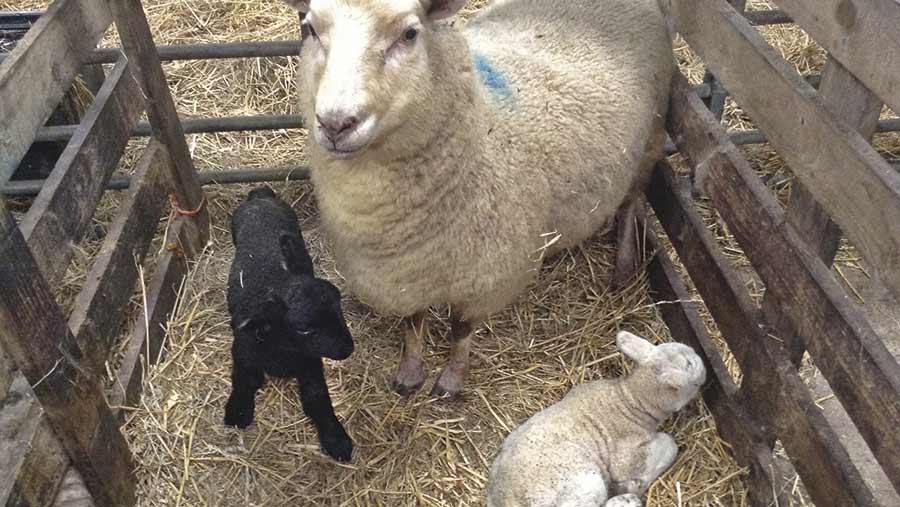
This is caused by an E coli infection usually in the first few hours of life. It is influenced by two things: the amount of bacteria ingested and amount of colostrum consumed.
When a lamb is looking for the ewe’s udder it may take in bacteria from the ewe’s fleece or bedding. In older lambs, which have already had sufficient colostrum, the pH in the abomasum is lower and this kills off the bacteria.
If a lamb hasn’t has enough colostrum the bacteria multiply rapidly in the lamb’s gut and as the bacteria die they release a toxin.
Small amounts do no harm, but higher amounts will affect gut motility and this leads to further multiplication and toxin production.
If the amount of toxin produced is greater than the amount which the liver can destroy it will lead to endotoxemia, which is what causes the signs seen in watery mouth.
Signs
- Initially dull and depressed with a reluctance to feed.
- Collapse.
- Excessive salivation giving the condition its name.
- Gas in the gut can be heard (rattle belly).
- Sometimes scour is observed.
- Lambs will usually die within a few hours.
Treatment
Treatment of individual lambs can be successful, but relies on early identification and intervention.
- Supportive care to keep the lamb hydrated using electrolyte solution. Colostrum feeds should be avoided until gut distention has gone down.
- Use of antibiotics can be helpful although they will initially cause an increased release of toxins as the bacteria die.
- Enemas can help to simulate gut movement and remove some of the bacteria from the gut (20ml of warm soapy water into the rectum).
Prevention
The key to controlling watery mouth is preventing lambs ingesting large quantities of bacteria, and ensure that lambs have sufficient colostrum intakes.
- Lambs should get 50ml/kg colostrum in the first two hours and a total of 10% of its bodyweight in first 24 hours.
- Ensure ewes are in correct condition so they produce plenty of good-quality colostrum.
- Extra attention should be given to at risk lambs (multiples and those born to poorer ewes).
- Regular cleaning of lambing shed and using plenty of clean, dry bedding.
- Winter shearing or dagging to reduce contamination of the fleece.
Preventative oral antibiotics should only be used in consultation with your vet and not as an excuse for poor hygiene. They should be avoided at the start of lambing when they shouldn’t be needed at all and only used once problems start.
Read Also: How to Ascertain the Quality of the Feed and Water to be served to the Ruminant Animals
3) Joint/navel ill
An infection of the joints or navel, caused by many different types of bacteria but always related to hygiene in the first few days despite signs often coming weeks later.
Signs
- One or more swollen joints.
- Swollen, wet navel.
Treatment
- Injectable antibiotics are required.
- Antibiotic spray can also be used on navels.
- Severe cases may need a vet to drain and flush the infected area.
Prevention
- Good hygiene in the lambing areas is essential.
- When applying tail and castration rings ensure clean equipment and technique.
- Ensure navel is covered with strong iodine (10%) solution as soon as possible after birth and check at 24 hours and redip if necessary.
- Dip cups get better coverage compared to spraying but should be regularly cleaned and have the solution replaced.
- Ensure adequate intake of good-quality colostrum.
4) Twin lamb disease (pregnancy toxaemia)
This is a disease of ewes usually in very late pregnancy and results from insufficient energy intakes to meet the requirements of the growing unborn lambs.
Progression can be rapid and can result in brain damage or death. Hypocalcaemia can often also be present as well.
Signs
- Depression.
- Loss of appetite.
- Apparent blindness.
- Progressing to recumbency.
- Often ewes carrying multiple lambs and in poor condition initially.
Treatment
- Oral drench with propylene glycol as soon as possible – 50ml twice daily.
- Calcium 20% injected under the skin in case hypocalcaemia is also present.
- Palatable feeds (good hay and concentrates).
In severe cases – call vet, they will consider:
- Intravenous glucose injection.
- Induction of lambing.
Prevention
- Correct nutrition in last two months of pregnancy.
- Scanning and condition scoring so feeding can be tailored to ewe’s requirements.
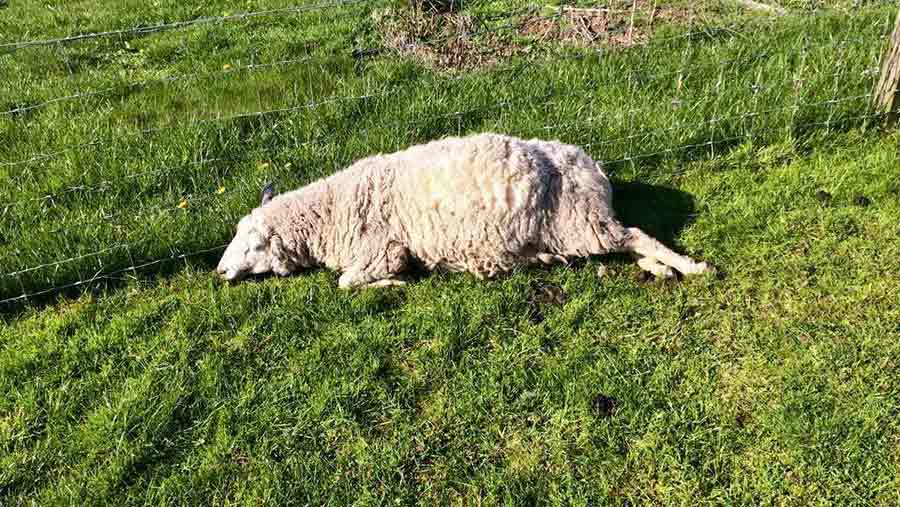
© Laura MacGregor
This is caused by abnormally low levels of blood calcium often follows a period of stress such as gathering, bad weather or housing.
It may co-exist with twin lamb disease and due to the rapid progression and often fatal outcome, treatment of both diseases is usually sensible.
Signs
- Unsteady on their feet progressing to recumbency.
- Neck turned back, muscle weakness and tremors.
- Increased respiration rate.
- Bloat and regurgitation may be noted.
Treatment
Injection of calcium – 80ml injected under the skin). Response is rapid (minutes). Also see treatment for twin lamb disease.
Prevention
- Avoid stress in late pregnancy – so handle carefully when gathered and avoid carrying out too many procedures at the same time (for example, worming, vaccination, fluke).
- Ensure adequate food supply during late pregnancy.
6) Listeria
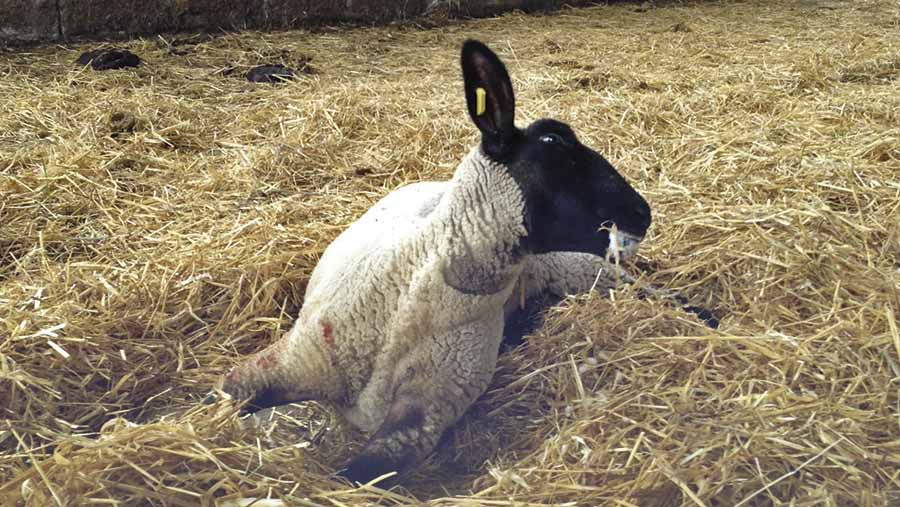
This is an infection caused by the bacteria Listeria monocytogenes which is found in soil environments. It is often associated with silage feeding as the bacteria multiply in the less acidic conditions.
Often outbreaks are seen two to three weeks after feeding off silage affecting less than 2% of the flock (but rarely up to 10%). The bacteria often gain entry through erupting teeth and track up the nerve to the brain.
Signs
- Younger ewes (18-24 months) most commonly affected due to erupting teeth.
- Lack of appetite.
- Depressed and disorientated.
- Food might be impacted in the cheek.
- Salivation.
- Facial paralysis results in lowered ear, dropping eyelid, flaccid lip and muzzle pulled over to side.
Treatment
- Antibiotic injections are sometimes successful – please consult your vet for best treatment.
- Even successful treatment takes time and the ewe will need supportive care such as soaked sugar beet to help eating.
- Administer propylene glycol to prevent energy deficit and twin lamb disease.
Prevention
- Discontinue use of the silage used approximately two weeks previously.
- Spoiled silage should be routinely discarded or fed to cattle which are less susceptible.
- Minimise soil contamination during silage making.
- Ensure punctured bales are repaired promptly and clamps are well rolled.
Read Also: An Estimate on the Cost of Raising 1,000 Fishes to Market Size
7) Vaginal prolapse
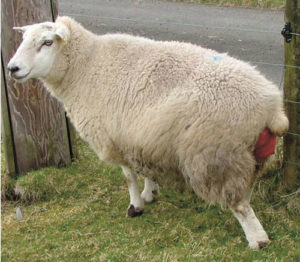
© Laura MacGregor
This is a protrusion of the vagina and occurs before lambing. Sometimes the prolapse will disappear once a ewe stands up.
Risk factors include overweight ewes, carrying triplets, limited exercise (lameness/recumbent).
Prolapse can go on to perforate allowing the ewe’s guts to protrude. They can cause abortion and also commonly cause incomplete cervical dilation (ringwomb).
Treatment
- Thoroughly wash and inspect for damage.
- Gently push prolapse back in using the palm of your hand.
- Use a spoon or harness to keep in place.
- Repeated cases/very large prolapse get a vet to replace under epidural injection and stitch in place.
Prevention
- Avoid allowing ewes getting overweight.
- Cull any ewes that have suffered a prolapse as it will repeatedly happen.
Read Also: Jollof Rice: Mix Spice, Recipe & Preparation



